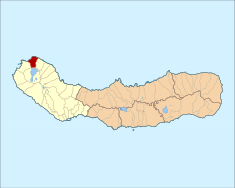Pilar da Bretanha
| Pilar da Bretanha | |
| Civil Parish | |
| Official name: Freguesia de Pilar da Bretanha | |
| Name origin: Portuguese for Pillar of Britain or Brittany | |
| Country | |
|---|---|
| Autonomous Region | |
| Island | São Miguel |
| Municipality | Ponta Delgada |
| Localities | Casa Telhada, Covas, João Bom, Pilar |
| Center | Lagoa do Pilar |
| - elevation | 222 m (728 ft) |
| - coordinates | 37°53′35″N 25°47′0″W / 37.89306°N 25.78333°WCoordinates: 37°53′35″N 25°47′0″W / 37.89306°N 25.78333°W |
| Highest point | Grota da Cova |
| - location | Sete Cidades Massif |
| - elevation | 522 m (1,713 ft) |
| - coordinates | 37°52′51″N 25°46′44″W / 37.88083°N 25.77889°W |
| Lowest point | Sea Level |
| - location | Atlantic Ocean |
| - elevation | 0 m (0 ft) |
| Area | 6.07 km2 (2 sq mi) |
| - urban | .43 km2 (0 sq mi) |
| Population | 624 (2011) |
| Density | 103/km2 (267/sq mi) |
| Settlement | fl.1500 |
| - Parish | 10 July 2002 |
| LAU | Junta Freguesia |
| - location | Rua Direito do Pilar |
| President Junta | José Botelho Carvalho |
| Timezone | Azores (UTC-1) |
| - summer (DST) | Azores (UTC0) |
| Postal Zone | 9545-068 |
| Area Code & Prefix | (+351) 292 XX XX XX |
| Patron Saint | Nossa Senhora do Pilar |
| Statistics: Instituto Nacional de Estatística | |
| Geographic detail from CAOP (2010) produced by Instituto Geográfico Português (IGP) | |
Pilar da Bretanha is a civil parish in the municipality of Ponta Delgada on the island of São Miguel, in the Portuguese archipelago of the Azores. It was de-annexed from the historical parish of Bretanha on 10 July 2002, along with Ajuda da Bretanha. The population in 2011 was 624, in an area of 6.07 square kilometres (2.34 sq mi).
There are controversies as to the origins of this parish, which was inhabited between the end of the 15th century and the beginning of the 16th century. The first colonists settled along the coast, from João Bom to Remédios. At one time these small communities were disparagingly referred to as the those places in the north by settlers in Ponta Delgada.
In a description by Francisco A. Chaves e Melo, the church in Pilar appeared as the center of religious life in this zone, before 1716, an area that encompassed not only present-day Pilar, but also João Bom. Little is known of the original chapel, which was dedicated to Nossa Senhora do Pilar (Our Lady of the Pillar), except for the writings of Dr. Ernesto do Canto, on his treatises on religious sanctuaries of São Miguel, titled O Preto no Branco. In his work, the author refers to the last testament of Captain João de Sousa de Vasconcelos, resident of Bretanha, who left certain items to the chapel in his will (16 March 1728). Owing to its state (practical ruins), during the second half of the 19th century, the chapel was reconstructed, taking on the church's current dimensions.
The chronicler and historian, Father Gaspar Frutuoso identified the region of Bretanha in the early part of the 1870s. As he wrote:
Many of these early settlers were referred to as former inhabitants of Great Britain or Brittany, and the region continued to be referred to as Bretanha throughout the centuries (many from former Templar settlements). The name stuck, even as the number of English residents dwindled in proportion to the native Portuguese that settled the lands increased. A study on the linguistic influences of Bretanha, by Maria Clara Rolão Bernardo, reaffirmed this early conviction, while Lacerda Machado noted the greater influence of immigrant populations from Alto-Alentejo subregion in the rest of the island. Frutuoso continued to identify a small community of 82 homes (in a region that extended from Nossa Senhora dos Remédios, in the northeast, to Mosteiros, in the northwest) and whose residents cultivated wheat and collected woad for export. Frutuoso, in particular, identified local resident Braz Alvres, a descendant of one of the earlier settlers, who gave his name to one of the peaks in the area (Pico de João Alvres), and who continued to tend his lands in the grotto of João Bom. Similarly, Pico da Mafra (which is located between Bretanha and Mosteiros), was named for a settler who came from the area of Mafra on the continent. It was Baron Fernandes, another resident of the grotto of João Bom, who discovered an interesting agricultural technique in order to perpetuate consistent crop yields in this region. In 1550, he came upon the idea of planting pulse (Lupinus albus) around the edges of his wheat crops, which had the effect of fortifying the wheat. He did the same for his beans, and discovered the same effects. The practice of using the pulse soon disseminated throughout the island and archipelago. Then, when another settler, Lopo Pessoa, arrived on the island he went one step further; he began to alternate his crops annually, between pulse and wheat, to increase his yields.
...
Wikipedia

